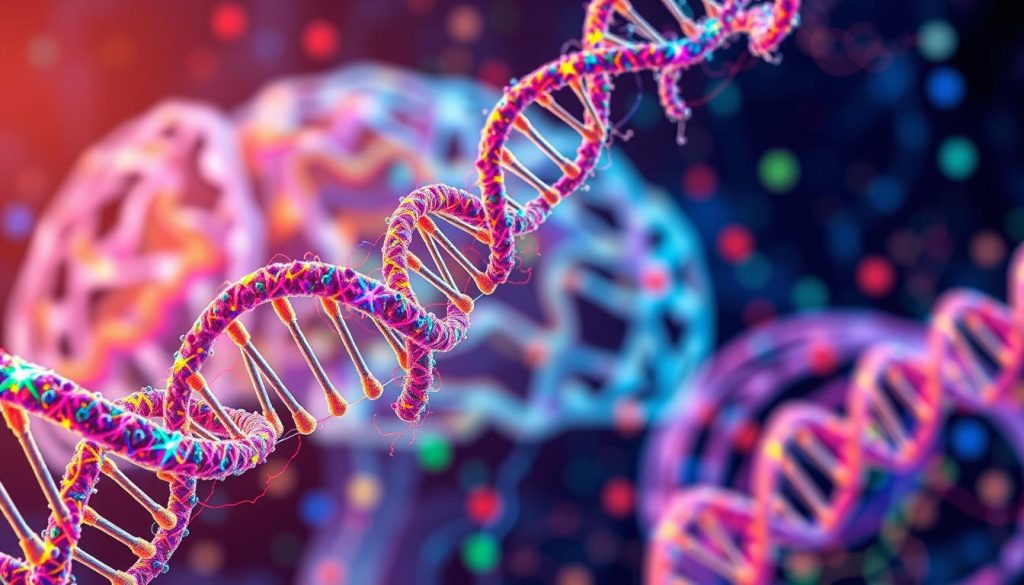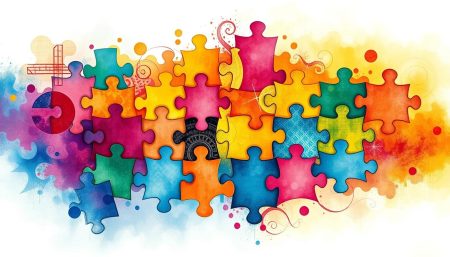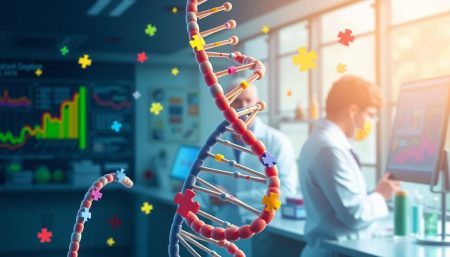Autism Spectrum Disorder (ASD) comes from differences in the brain that show up in many ways. These signs and symptoms of autism spectrum disorder are what help us see if someone might have it. They are like a map that shows how a child sees the world. It’s very important to spot these signs early. This helps us understand autism better. It also opens doors to support and help that fits each person’s needs.
Exploring ASD is not just about listing traits. It’s about sparking thought, understanding, and kindness. Finding signs is a big step toward accepting and supporting neurodiversity. This article aims to show the many sides of autism with care and clarity.
We want to help you see the small and big signs that can change someone’s life. These signs are key to helping and supporting those on the autism spectrum.
What is Autism Spectrum Disorder?
Autism Spectrum Disorder (ASD) is a complex condition that affects social interaction, speech, and behavior. It is present from early childhood and impacts daily life. The symptoms and severity vary greatly among individuals.
The term “spectrum” in autism spectrum disorder means there’s a wide range of symptoms and severity. It covers a broad spectrum of skills and impairments. Diagnosis often happens in childhood and involves genetic testing, neurological assessment, and developmental review.
Understanding the characteristics of autism is key for early intervention. Early help can greatly improve a child’s life. Signs include challenges with communication, social interactions, obsessive interests, and repetitive behaviors.
- Detailed and nuanced observation is essential for any autism diagnosis.
- It is important to note that no two individuals with autism are the same, and each autism spectrum disorder can manifest differently.
| Aspect of Autism | Common Sign | Possible Support Strategies |
|---|---|---|
| Social interaction | Difficulty in understanding social cues | Social skills training and therapy |
| Communication | Delay in or lack of language development | Speech therapy |
| Behavior | Repetitive actions or speech | Behavioral intervention plans |
As it is a spectrum disorder, autism spectrum disorder includes syndromes like Asperger’s syndrome and childhood disintegrative disorder. It was once seen as separate conditions.
Key Characteristics of Autism in Children
Autism in children shows through unique behaviors and developmental signs. Understanding these traits early helps in better helping children with autism spectrum disorder (ASD). Early detection is key to improving how we help them.
Communication Challenges
Children with autism face big challenges in talking and understanding language. They might repeat words or speak in a flat tone. They also struggle with non-verbal cues like eye contact and facial expressions.
Social Interaction Difficulties
Autistic kids often find it hard to connect with others. They might not want to make friends or understand social hints. They often prefer to be alone and struggle in group settings.
Repetitive Behaviors and Routines
Children with autism love routine and sameness. They might do the same movements over and over or get very interested in certain topics. Changes in their routine can cause them a lot of stress and worry.
Early Signs of Autism in Toddlers
Spotting the early signs of autism in toddlers is key for early help. Autism in children shows up in different ways, like delays in development and odd behaviors. This part talks about important signs that might mean a child needs a check-up.
- Lack of eye contact
- Delayed speech development
- Minimal social interaction with peers and caregivers
- Repetitive movements such as rocking or spinning
Autism red flags in toddlers often mean they’re not hitting usual growth points. Parents and caregivers should watch how the child plays, learns, talks, and acts. This helps spot early signs of autism spectrum disorders.
| Age | Expected Milestone | Potential Autism Indicator |
|---|---|---|
| 12 months | Responds to name | Does not notice when called |
| 18 months | Imitates actions or words | Lack of imitation of gestures or sounds |
| 24 months | Engages in simple pretend play | Does not engage in or sustains very limited pretend play |
Watching for early signs of autism is vital for diagnosis and starting the right treatments. If you see several autism red flags, talk to a healthcare provider for a full check-up.
How Autism Manifests Differently in Individuals
Autism Spectrum Disorder (ASD) shows a wide range of symptoms and behaviors. Each person faces unique challenges and strengths. It’s important to understand the diversity in ASD, from high-functioning to nonverbal autism.
Knowing these differences helps tailor support and interventions better.
High-Functioning Autism
People with high-functioning autism often have average to above-average intelligence. Yet, they may struggle with emotional and social interactions. They can express their thoughts well but find social situations hard.
This group can do daily tasks on their own. But they also show signs of autism like fixated interests and strict routines.
Nonverbal Autism
Nonverbal autism affects a person’s ability to speak. Despite not using many words, they can communicate in other ways. They might use gestures, expressions, or symbols and technology to get their message across.
They face big challenges in communication. But they might be great at visual skills, music, or solving puzzles.
The differences between high-functioning and nonverbal autism highlight the need for personalized care. Understanding these variations helps create better support systems for everyone with autism.
Understanding the Signs and Symptoms of Autism Spectrum Disorder
To support an autism diagnosis, knowing about autism is key. The signs and symptoms of autism spectrum disorder are diverse. Spotting these common signs is a first step towards a correct diagnosis. Here’s a list of main signs to help caregivers and teachers spot early signs.
- Lack of or delayed speech and language skills
- Frequent repetition of words or phrases (echolalia)
- Minimal interest in social interactions or activities
- Aversion to physical contact or affection
- Unusual reactions to sensory inputs like sound, light, or touch
- Intense focus on specific topics or objects
- Need for routine and adverse reactions to changes in it
- Engaging in repetitive movements, such as rocking or spinning
It’s also important to consider the environment and development when diagnosing autism. We’ll show how symptoms can vary in different settings:
| Environment | Symptoms at Home | Symptoms at School or Daycare |
|---|---|---|
| Communication | Delay in starting to talk, using limited gestures | Difficulty following instructions, poor peer interactions |
| Social Interaction | Lack of interest in family activities | Struggles with group work, not interacting during social games |
| Behavioral | Routine-dependent, distress during disruptions | Upset by changes in classroom layout or unexpected schedule changes |
By recognizing these signs and symptoms of autism spectrum disorder, we can start talking to doctors about autism. This awareness leads to better support systems. It improves life and development for those on the autism spectrum.
Diagnosing Autism: The Assessment Process
The journey to an autism diagnosis is complex and needs a careful autism assessment process. Knowing this process can ease some of the worries families have. We will explain the important role of professional evaluations and why early autism screening is key.
Professional Evaluations
Professional evaluations are the first step in diagnosing autism. They use standardized tests to check developmental levels and find autistic traits. These tests include interviews with parents, watching the child’s behavior, and interactions with experts.
These assessments help understand a child’s strengths and challenges. They guide the next steps in managing and helping the child.
The Role of Early Screening in Autism
Early screening is critical in pediatric visits to spot children at risk for autism. It uses special tools to find developmental delays early. This allows for quick referrals for more detailed evaluations.
These early screenings are key to catching signs that might be missed. They help start early intervention services. These services can greatly change a child’s development path.
Knowing what assessments involve can clear up the autism assessment process. Here’s a list of common tools used:
| Evaluation Tool | Description | Purpose |
|---|---|---|
| Autism Diagnostic Observation Schedule (ADOS) | Task-based observation | Profiles autism-specific behaviors |
| Autism Diagnostic Interview-Revised (ADI-R) | Parent interview | Detailed family history and developmental information |
| Childhood Autism Rating Scale (CARS) | Behavior rating scale | Evaluates severity of autism |
Each tool offers unique insights into the autism diagnosis. Together, they give a full picture of a child’s development. Early detection and thorough assessments are vital for creating effective intervention plans for each child.
Autism Red Flags Parents Should Watch For
Spotting early autism warning signs is key for parents and caregivers. Knowing autism red flags can help get help early. This can greatly improve autism in children. Here are some signs that might mean a child should be checked for autism.
- Lack of eye contact: Trouble keeping eye contact is common in kids with autism.
- Delayed speech development: Not hitting speech milestones could be a autism warning sign.
- Repetitive behaviors: Doing the same actions over and over, like rocking or hand-flapping, might show autism.
Seeing these signs is important for early help and support. Looking at more autism red flags can give deeper insights.
| Age | Sign | Description |
|---|---|---|
| 1-2 Years | Limited pointing or gesturing | A lack of gestures like pointing to show interest or desire. |
| 2-3 Years | Poor social interactions | Having trouble with friends, preferring to be alone. |
| 3-5 Years | Resistance to changes in routine | Getting upset or throwing tantrums when things change unexpectedly. |
Spotting these autism warning signs early lets parents get help fast. This can lead to early support strategies.
Behavioral Patterns Indicative of Autism
Understanding autism behavioral patterns and characteristics of autism is key. It helps us see how autism shows up in people. These patterns can really impact how someone lives their day-to-day life and interacts with the world.
Obsessive Interests and Activities
People with autism often get really into certain things. They might collect specific items or focus a lot on subjects like math or astronomy. This deep interest can help them get better at certain skills. But it can also make it hard for them to connect with others and handle everyday tasks.
Sensory Processing Differences
The sensory processing autism side is a big challenge. Some might be very sensitive to sounds, lights, or touch. Others might not react much to these things. It’s important to understand these differences to make environments more supportive. You can find out more about this by reading this detailed exploration of autism.
This look into obsessive interests and sensory processing differences helps us understand some unique behaviors of autism. By recognizing and working with these behaviors, we can offer better support. This can improve their life and help them grow.
The Importance of Autism Awareness and Understanding
Our understanding of autism spectrum disorders (ASD) is growing. This makes autism awareness and education more important than ever. It helps us be more empathetic and create supportive environments for those with autism.
It’s key to build understanding autism for inclusive places in schools, workplaces, and communities. Knowing more about autism helps us better support those on the spectrum. Also, strong autism support systems help families and individuals face daily challenges.
- Increased sensory-friendly options in public and private venues
- Enhanced training for educators and healthcare providers
- Greater access to resources and support networks
Another important part of autism awareness is fighting stigma. Misunderstandings can lead to exclusion. By spreading awareness, we move towards acceptance and support, reducing stigma and fostering empathy.
| Aspect | Impact |
|---|---|
| Educational Programs | Improved personalized learning plans |
| Workplace Integration | Higher employment rates among individuals with autism |
| Community Awareness | Reduced social stigma and enhanced community engagement |
By supporting autism awareness, we open doors for new research and better policies. This leads to more autism support for everyday life and long-term success for those with autism.
Physical and Motor Signs of Autism Spectrum Disorder
Spotting the signs of autism spectrum disorder is not just about behavior and social signs. It also includes looking for physical signs. These signs can help find autism early and start treatment sooner.
Unusual Gait or Posture
One key autism motor skills issue is an odd way of walking or standing. This might show as walking in an odd way, not evenly, or awkwardly. These differences often point to problems with muscle coordination and brain development linked to autism.
Coordination Challenges
People with autism often struggle with coordination. This makes it hard for them to do normal physical activities. They might have trouble learning to ride a bike, be clumsy, or struggle with complex movements.

| Aspect | Typical Development | Autism Spectrum Disorder |
|---|---|---|
| Gait | Even and rhythmic | Irregular or asymmetrical |
| Posture | Upright, balanced | May exhibit slouching or unusual stiffness |
| Motor Coordination | Smooth and coordinated | Clumsy, delayed development in coordination skills |
| Physical Activity Engagement | Active, varied | Limited, possibly avoids physically demanding tasks |
Autism Spectrum Disorder Indicators in School-Aged Children
Finding autism indicators in school kids is key. It helps spot autism early, leading to quick help and support. School years bring new challenges where autism in school-aged children might show up more, like in schoolwork.
Teachers and parents need to know about signs of autism in school. These signs include social, behavioral, and learning clues. Here’s a detailed look at some important signs.
| Indicator | Description | Observation Context |
|---|---|---|
| Difficulty with Social Interaction | Challenges interacting with peers, understanding social norms, or engaging in group activities. | During recess, group activities, or team-based learning. |
| Resistance to Changes in Routine | Displays distress or confusion when unexpected changes to school schedules or routines occur. | Changes in classroom setup, substitute teachers, or altered timetables. |
| Inconsistent Academic Performance | Variable performance in different subjects, with struggles in subjects needing social understanding. | During assessments, group projects, or subjects like history and literature which imply social contexts. |
| Hyper- or Hypo-Reactivity to Sensory Input | Overly sensitive or indifferent to sensory stimuli such as sounds, lights, or physical contact. | During assemblies, physical education classes, or in environments with bright lights or loud noises. |
Also, watch how the child reacts to social cues and verbal instructions. Spotting autism early can really help their school life and growth.
Emotional Regulation and Autism
Understanding and managing emotions is tough for people with autism. This part looks at autism and emotional regulation. It talks about autism meltdowns and shutdowns. And it shares good autism coping strategies.
Understanding Meltdowns and Shutdowns
People with autism can have big reactions to too much stress. These are called meltdowns and shutdowns. A meltdown is when someone can’t handle it anymore and loses control. It’s not a tantrum, but a real emotional overload.
Shutdowns are when someone pulls back and stops responding. They might seem unresponsive or distant. It’s important to know how to help them feel better.
Coping Strategies for Emotional Management
It’s important to find ways to handle feelings that get out of control. Here are some strategies:
- Identify what sets off meltdowns or shutdowns. Knowing this can help prevent them.
- Use tools like noise-canceling headphones or weighted blankets to block out too much.
- Stick to a routine. It makes things feel safer and less unpredictable.
- Use pictures or apps to talk about feelings and needs. This is really helpful for those who can’t speak easily.
Using these strategies helps not just in the moment. It also helps with managing feelings over time.
| Strategy | Description | Examples |
|---|---|---|
| Identification of triggers | Understanding specific situational or environmental catalysts | Loud noises, crowded spaces |
| Sensory tools | Items that help reduce sensory input | Noise-canceling headphones, weighted blankets |
| Structured routines | Regular and predictable schedules | Daily timetable, pre-planned breaks |
| Communication support | Tools assisting in expressing needs and feelings | Visual support cards, communication apps |
Autism in Girls vs. Autism in Boys
Understanding the gender differences in autism is key to better support. Historically, autism in boys has been more recognized than autism in girls. This might be due to gender bias in how we diagnose or how autism shows up differently in each gender.
Girls with autism might show signs that are less obvious, like internal behaviors. This can lead to them being overlooked or misdiagnosed. Boys, by contrast, often have behaviors that are more noticeable and disruptive, making it easier to see they have autism.
- Girls may engage more in passive activities, often going unnoticed in social settings.
- Boys might be more prone to exhibit hyperactivity and aggressive behaviors.
These differences can affect how well each gender adapts socially and in school.
| Aspect | Autism in Girls | Autism in Boys |
|---|---|---|
| Social Interaction | May have one or two close friendships; struggles might be internal and less visible. | Often displays difficulties in larger social groups; interactions are visibly marked by autism. |
| Behavioral Patterns | Subtle manifestations such as withdrawal or imaginary play. | More likely to engage in repetitive behaviors that are easily identifiable. |
| Challenges | Underdiagnosed due to societal perceptions and subtler symptom presentation. | Frequently diagnosed but might receive too generalized support that doesn’t cater to individual needs. |
It’s important to recognize these gender differences in autism for better diagnosis and support. Tailored interventions can help each child thrive. With more awareness, we can improve outcomes for all on the autism spectrum.
Social Cues and Autism: Recognizing the Subtleties
For those on the autism spectrum, understanding social cues autism is different. This affects how they interact socially. It’s key to grasp these differences to support and include them better.
People with autism might miss or misread body language, facial expressions, and tone of voice. This can cause misunderstandings and social anxiety. So, using communication strategies made for them is very important.
- Sensitivity to Eye Contact: A direct stare may feel overwhelming.
- Literal Interpretation: Sarcasm and jokes are often taken seriously.
- Subtle Gestures: Small nods or facial changes might go unnoticed.
Having a good support system is key for better autism social interaction. It’s important to teach both neurotypical and autistic people about autism. This helps everyone understand social situations better.
| Cue Type | Typical Interpretation | Interpretation by Individual with Autism |
|---|---|---|
| Verbal Irony | Understood as non-literal | Often taken literally |
| Facial Expressions | Communicates non-verbal cues | Might not be recognized |
| Physical Distance | Suggests personal space preferences | May not be perceived or respected |
Learning more about these social cues can help a lot. It makes daily interactions better and helps us recognize autism more accurately. By understanding these subtleties, we can make places more welcoming for those on the autism spectrum.
The Role of Genetics in Autism Spectrum Disorder
Looking into genetics and autism has given us important insights into autism spectrum disorder (ASD). Recent autism research shows that genetics play a big role in ASD. But, it’s clear that genetics is only part of the story.
Genetic links mean ASD can sometimes run in families. This makes studying genetics key for early diagnosis and help.

Science has made big strides in autism research. It has found several genes linked to ASD. These discoveries help us understand the hereditary side of ASD and possible genetic issues that might cause it.
The wide range of autism symptoms shows how different genetics can affect people. This highlights the unique nature of autism and how it should be treated.
- Understanding genetic mutations linked to ASD fosters personalized treatment plans.
- Genetic testing for families could lead to earlier interventions and support services.
- Research in genetics and autism drives the development of targeted therapies.
Even with the progress in autism spectrum disorder genetics, it’s clear that environment and genetics work together. This complex mix affects the risk of ASD. More research is needed to understand these interactions. It will help us find better ways to manage ASD and improve life for those affected.
Supporting Children with Autism: Therapies and Interventions
Helping children with autism means using many different approaches. These therapies aim to improve their skills and help them deal with everyday life. They focus on communication, social, and thinking abilities.
Good autism treatments can make a big difference. They help kids become more independent and social. These efforts include behavioral methods like Applied Behavior Analysis (ABA) and developmental programs like the Denver Model.
Every child with autism is different. So, it’s important to have a plan that fits them. A team of experts, including speech and occupational therapists, work together. They aim to meet specific needs, like improving speech or handling too much sensory input.
Parents and teachers play a big role in helping these kids. They can use strategies like sensory integration therapy or social skills groups. These help kids interact better with others and adapt to new situations.
In short, supporting kids with autism requires a personalized approach. Keeping up with new therapies and working closely with healthcare providers is key. This way, we can help them grow and reach their full abilities.
FAQ
Q: What are the early signs and symptoms of autism spectrum disorder in children?
A: Early signs include not making eye contact and limited speech. They also include not responding to their name and repetitive behaviors. Unusual interests and trouble with social interactions are also signs.
Q: How is Autism Spectrum Disorder diagnosed?
A: Diagnosis starts with input from parents and a look at the child’s development. Healthcare professionals, like psychologists and neurologists, observe the child’s behavior. They use special tools to make the diagnosis.
Q: What are some of the key characteristics of autism in children?
A: Key traits include communication challenges and trouble with social interactions. They also have repetitive behaviors and a strong need for routines.
Q: How can autism manifest differently in various individuals?
A: Autism can show up in many ways. Some have strong verbal skills, while others may not speak at all. Each person’s autism is unique.
Q: What is the importance of recognizing the early signs of autism in toddlers?
A: Spotting autism early is key. It means kids can get help sooner. This help is important for their future.
Q: Why is autism awareness and understanding important?
A: Knowing about autism helps everyone. It leads to better support and inclusion. This way, people with autism can do well in society.
Q: What red flags should parents watch for that could indicate autism?
A: Look for signs like not smiling and delayed speech. Also, watch for repetitive movements and resistance to change. Trouble with eye contact and social games is another sign.
Q: Why is early screening for autism important?
A: Early screening finds kids who need help early. This early help improves their language, social, and thinking skills later on.
Q: What are common behavioral patterns indicative of autism?
A: Common signs include obsessive interests and strict routines. They also have sensory sensitivities and repetitive movements like rocking.
Q: How do physical and motor signs manifest in individuals with autism spectrum disorder?
A: People with autism might have unusual ways of moving. They might have trouble with fine and gross motor skills. Their posture and gait can also be different.
Q: What are some indicators of autism in school-aged children?
A: Signs include trouble with social interactions and understanding abstract concepts. They might struggle with changes in routine or environment. Learning differences are also common.
Q: How can emotional regulation be a challenge for those with autism?
A: Many with autism find it hard to manage their feelings. This can lead to meltdowns or shutdowns. It’s important to find ways to help them cope.
Q: Are there gender differences in how autism presents in children?
A: Yes, there are differences. Boys might show more repetitive behaviors. Girls might be better at hiding their symptoms, leading to underdiagnosis.
Q: How do individuals with autism perceive social cues differently?
A: They might struggle to understand body language and tone of voice. This can cause misunderstandings and make social interactions hard.
Q: What role do genetics play in autism spectrum disorder?
A: Genetics play a big part in autism. Many genes are involved. But, the exact cause is complex, with both genetics and environment playing a role.
Q: What therapies and interventions are available to support children with autism?
A: There are many options. These include behavioral therapies, speech and occupational therapy, and educational support. Sometimes, medications are used to help manage symptoms.


















